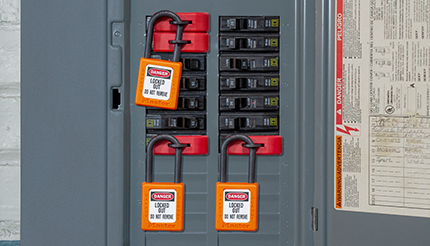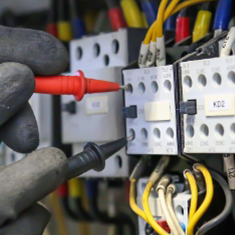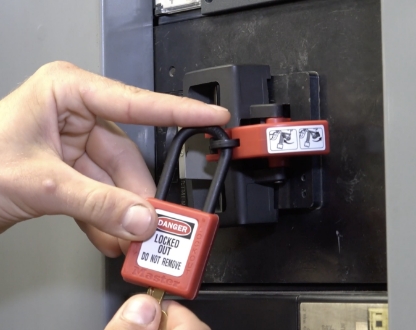- Accueil >
- Security and Safety Insights >
- How to find the best lockout tagout methodology for your facilities
How to find the best lockout tagout methodology for your facilities

Keeping employees safe during machine service and maintenance critical, complicated and a significant undertaking. And there are a couple of different ways to go about it. Most organization swill determine who to lock out based on the type of lockout required by the hazard or task. But analyzing the task may result in a different outcome than analyzing the hazard. How can you pick the best lockout tagout methodology for your facilities?
What type of Lockout? Choosing your methodology.
Implementing a lockout management system is a large undertaking. Ensuring the safety of your employees during machine servicing and maintenance is critical and complicated. Assessing the risk based on the hazard and/or the task allows organizations to determine who should lock out by the type of lockout required for the hazard or task.
Assessing risk based on an analysis of the task (e.g. unjamming a machine, repositioning, tool changeovers) or an analysis of the hazard (e.g. rotating parts) may result in two different outcomes of the type of lockout that is needed to be performed.
How lockout tagout methodology changes
Unjamming a machine could be viewed as a minor task that occurs frequently throughout a shift and after the hazard analysis is completed, the organization can decide that it is best done under control power (stop button, interlock, light curtain) versus a complete zero energy state (lockout) of the machine.
However, after an analysis of the hazard (rotating parts) is done, it is determined that based on the risk to an employee, full lockout is required based on it falling into a category outside of minor servicing. This determination requires a choice by the organization:
- Do we continue with only our maintenance personnel authorized to lockout?
- Do we take the approach of training and authorizing our machine operators to participate in the lockout program?
Most organizations choose to designate maintenance personnel as their authorized lockout personnel. Meaning that any time a machine needs servicing or maintenance, the maintenance personnel needs to be summoned - causing critical downtime to production.
Other organizations train machine operators as authorized employees. This allows machine operators to perform basic maintenance tasks on the machines they operate. Selecting your approach will depend on your organizational needs. And no matter which approach you choose; your written lockout policy must designate which employees are authorized to perform which tasks. This inclusion in your lockout policy is important to reduce injury risk due to miscommunication.
Is operator lockout right for your organization?
To determine if operator lockout is right for your facility, you must first evaluate your machinery as well as employee skill.
Some machinery requires more unjamming, adjustments, lubricating, and other preventative maintenance than other machinery. If your facility has machines that need to be adjusted or serviced per job or run, you may want to have more flexibility in who can lockout the machines to perform some of these tasks.
Operator lockout considerations
Equipment-specific, zero energy written lockout procedures are required by OSHA 1910.147. When implementing operator lockout, it becomes even more important to specifically list out and designate which maintenance tasks should be done by which authorized individuals within your lockout policy and train to that standard.
A risk of designating operators as authorized personnel is the potential for them to engage in lockout activities outside the scope of what the organization has instructed. Involving others in the lockout program such as floor supervisors as lockout leaders, who understand and champion the lockout process is a great way to promote safe lockout.
Having involved and enthusiastic lockout leaders is a vital part of the operator lockout philosophy. A floor supervisor who understands when and why machines are being locked out creates the opportunity to get maintenance staff involved when they need to be involved and ensures that machine operators are following every step of the lockout process each time.
Operator lockout equipment strategies
Lockout equipment availability is also very important when implementing operator lockout. Your facility must strategically locate all the correct and applicable lockout equipment within a short distance of each workstation. If lockout equipment is not convenient, the likelihood of operators bypassing important lockout steps increases.
A Lockout equipment strategy may include Lockout padlocks and devices at the machine or possibly at 6S boards. This is a great way to ensure access to the equipment. Engraving operator locks with numbers in a set and key number injects efficiency in equipment inventories. A single color designated as operator locks creates a visual factory by observation, a supervisor knows by the color of lock who is locking a machine out and what tasks are being performed.
Finally, a key strategy for operator safety locks may be a set of keyed-like locks so a single key opens all the locks assigned to that specific machine. A duplicate key may be housed in a supervisor’s office and can be obtained per the organization’s lockout policy.
Closing thoughts
Your lockout management system will depend on the needs and capabilities of your organization. Many facilities choose to train machine operators to be authorized personnel to improve daily efficiency and to empower their employees to make safety an everyday priority. Regardless of your selection, creating and following a thorough lockout program will reduce the likelihood of incidents and deficiencies of compliance.
From available resources to organizational structure, there are multiple factors that weigh into the approach that works best for each organization. Regardless of the approach and the strategies you use, Master Lock has the expertise to design and implement a complete lockout solution by formalizing lockout policies, procedures, and training in a clear, concise, and compliant manner in accordance to your organizational policy.
If you’re interested in working with Master Lock to create a comprehensive lockout program, get in touch with one of our experts today.




